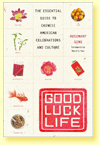| |
Chinese
New Year is a time of new beginnings and intentions.
Families sit down to feast on foods of good fortune once
the clutter of the home, finances, and even the mind is
cleared for a time of reflection, recognition, and renewal.
More | Top of Page
Qing Ming
It’s a traditional Chinese belief that a person’s
good fortune is directly linked to the happiness of one’s
ancestral
spirits. The best time to secure the family’s elders’ joy
is during the Clear Brightness Festival, also known as
Qing Ming (pronounced “Ching Ming”). It’s a springtime
holiday around April 4-6, or 106 days following the winter
solstice, that acknowledges the dead in a cemetery ritual.
Qing Ming is a Chinese holiday that corresponds to the
Gregorian calendar.
More | Top of
Page
Dragon Boat Festival
Qu Yuan, one of China’s most impassioned poets from
over two thousand years ago, lives on through the insistent
beat of a dragon boat’s drum, the synchronization
of a crew, and the roar of a crowd during the Dragon
Boat
Festival. The fifth day of the fifth lunar month, also
known as Double Fifth, is the second of three Chinese
festivals that are widely celebrated and designated for
the living. (The others are Chinese New Year and the
Mid-Autumn Festival.)
More | Top of
Page
Double Seventh Day draws on the romantic Chinese folktale
of the Cowherd and the Weaving Maiden. On Seven-Seven,
these clandestine lovers, eternally separated from one
another except on this one night, are reunited by a bridge
of magpies. Although the festival of Seven-Seven is not
widely observed in America, it’s a holiday full of ritual
to satisfy the heart’s romantic desires.
More | Top of
Page
Festival of Hungry Ghosts
According to the Chinese almanac,
the gates of the underworld are opened on the seventh month,
releasing
the
hungry ghosts
to roam the earth on holiday. To pacify these forgotten
souls, the Chinese provide offerings to them on the fifteenth
day (Seven-Fifteen), during the Festival of Hungry Ghosts.
It’s a Chinese version of All Souls’ Day, when the living
appease the ghosts with a feast all their own.
More | Top of
Page
The
Festival of the Mid-Autumn Moon is celebrated
on the eighth lunar month, fifteenth day (Eight-Fifteen),
which typically falls in September on the solar calendar.
It’s a Chinese holiday of thanksgiving when wishes
are sent to the Moon Goddess, moon cakes are shared after
a family dinner, and the year’s brightest moon
is worshipped.
More | Top of
Page
Double
Ninth Day is the ninth lunar month, ninth day,
and is known as Chong Yang, which means “Day
of the Double Sun.” It represents the end of autumn,
a season the lunar calendar places in the seventh, eighth,
and ninth months.
Like many Chinese holidays practiced to beckon good fortune,
Double Ninth focuses on advancing success, inviting long
life, and escaping danger.
More | Top of
Page
The
Winter Solstice is a time when Chinese families
gather for dinner to give thanks at the end of the year.
The
featured food item is tang yuan, rice flour
dumplings that can either be served “salty” in a soup, or “sweet” as
a dessert because sharing and eating tang yuan symbolizes reunion.
More | Top ofPage
|
